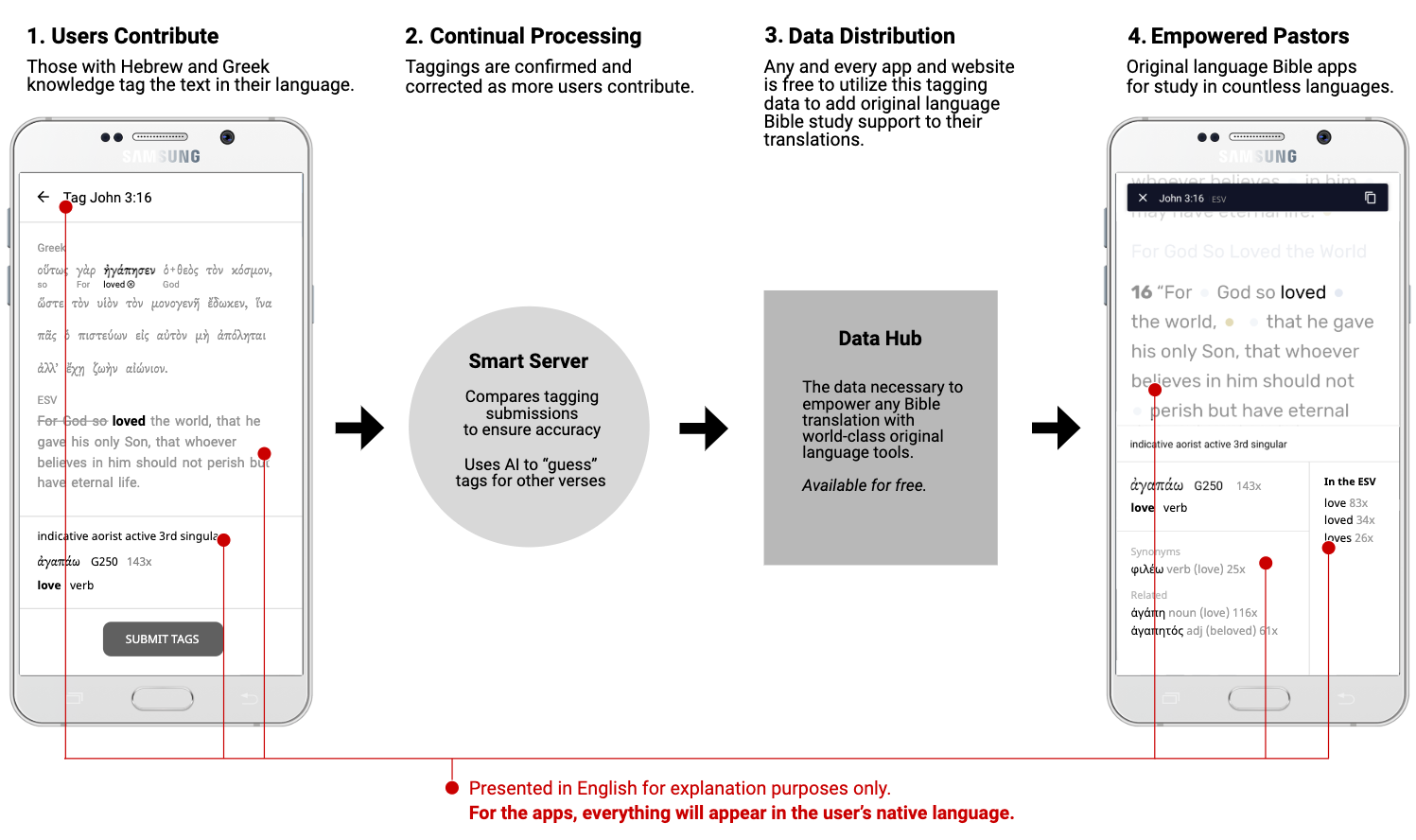Project Details
But How?
If you are reading this, it is likely you are already sold on the worth of providing original-language Bible tools to pastors around the world. But as nice as that vision sounds, it does not mean much unless there is an actual path to accomplish it. That path is outlined below.

Step 1: Crowd-Sourcing Tagging Data
While the original language tools available at Biblearc are already a big help to those who already know Greek or Hebrew, their value will be more limited for those just learning. But not for long.
Once a translation is tagged to the original languages, the door of accessibility swings wide open. The way this happens is through “crowd-sourcing” tagging data (sometimes called “alignment data”) between a translation and the original languages from users who know the original languages. This is facilitated by providing an easy way for users to indicate which word(s) in their translation correspond to which word(s) in the original, all within the app itself.
Steps 2-4: A Good Tool That Gets Better and Better
As soon as a user tags a particular verse, that tagging (i.e. connection between the words in the translation to the words in the original) will be displayed to other users, accompanied by an “provisional” flag. As other users confirm (or correct) this tagging, the system will intelligently remove the flag. Another sort of artificial intelligence will be utilized to also guess at the proper tagging of other verses, again presenting the “auto-match” flag until those guesses are verified. Finally, contributor ratings will also play a big part, increasing or decreasing as their taggings are confirmed or corrected, so as to maximize the accuracy of the data.
The result: An even better original-language powered Bible app in different languages with advanced tools that are particularly crucial for those learning the original languages.
The additional functionality will include:
- tap on any word in a Bible translation in order to study the original language word behind it
- start an original language search from a word in the translation
- a gloss (i.e. simple definition) of each original language word in the language of the app, automatically derived from how it is translated throughout the given Bible translation, and editable by the most highly rated contributors
- break-down of how often and where an original language word is translated
Crucial Original Language Data for the Church
The result of the process described above will not only be a wonderfully improved app, but also an open-source and free hub of data to serve the global Church in yet other ways. The possibilities are endless. And there will be no strings attached. Anyone and everyone will be free to utilize this hub of data connecting words* in Bible translations to the original languages.
FAQ
Will the tagging data be accurate?
In one way, the crowd-sourcing approach in this project might be compared to Wikipedia. But that raises a concern, because not everything you find on Wikipedia is accurate! But there really need not be a concern given the way our approach differs from Wikipedia.
The tagging submissions we are asking users to make, unlike Wikipedia, are black-and-white in nature. That is, there is a right answer. This is due to the fact we are asking users to simply tell us which word(s) in the translation are associated with which word(s) in the original. Will there be mistakes made? Of course, but those will be easily corrected by the smart server as described in the verification process above.
Each of these wonderful ministries provides various original language Bible study tools and also brings in non-English Bible versions. Some of them also translate their interfaces into different languages. What they do not have, however, is the data necessary to connect non-English Bible translations to the original text, nor do they have a way to create that data.
And this is critical! Without data tying Bible translations in Persian and Arabic and Hindi to the original Hebrew and Greek, they can only provide very limited original language helps—not nearly sufficient to empower pastors in those languages. Nor can these sites presently provide lexicons in all the different end-user languages.
This is where Bible Tags comes in. Our approach will produce the necessary data so that web apps like these and many others can get better! Thus, Bible Tags is not an alternative to any of these great tools, but rather looks to serve these tools by producing an open-source data hub from which they will be able to draw.